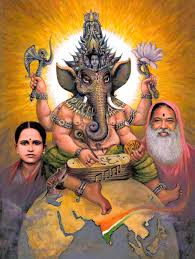Trivikramāya namah.
Maharishi Śuka continued, “Therefore I shall explain only the names of the various divisions of the vast earth, their dimensions and prominent characteristics. Jambū-dvīpa, within which we reside, is the innermost circle (division) in the concentric circles that constitute the lotus flower called Bhu-manḍala. (Bhu-manḍala is planetary system of earth, which consists of 7 divisions separated by 7 oceans).
The measure of this island called Jambu-dvīpa is 1 lakh yojanās (8 lakh miles). It is symmetrical and round like a lotus leaf. Within Jambū-dvīpa there are 9 zones. Each of these zones is 9000 Yojanās (72,000 miles) wide and is beautifully bordered by mountains.
Among these zones is an island called Ilāvṛta. Within Ilāvṛta is the golden Sumeru Mountain, which is the most supreme among all primary mountains. Mountain Sumeru is 1 lakh Yojanās in height of which 16,000 Yojanās are deep inside earth. In other words, the height of this mountain is the same as the length of the Jambu-dvīpa island. Mountain Sumeru is like the filament to the lotus called Bhu-manḍala. At its peak it is 32,000 Yojaṇas wide while its base is 16,000 Yojanās wide.
To the North of Ilāvṛta Island are the Ramyaka, Hiraṇmaya and Kuru zones (varṣa) which are bordered by Nīla, Śweta and Śṛngavanta Mountains respectively. Each of these mountains measures 2,000 Yojānas (16,000 miles) from east to west and they stretch up to the salty ocean. In length Śweta is one-tenth of Nīla; while Śṛngavanta is one-tenth of Śweta. However they are of the same height.
Similarly to the South of Ilāvṛta Island are the Hari, Kimpuruśa and Bhārata zones which are bordered by the Niṣadha, Hemakuṭa and Himālaya Mountains respectively. Like Nīla and other mountains these mountains too extend from east to west. Each of them is 10,000 Yojanās (80,000 miles) in height.
To the West of Ilāvṛta Island is the Mālyavanta Mountain and on the East is the Gandhamādhana Mountain. Each of them is 2000 Yojanās (16,000 miles) high. In the north they extend up to Mount Nīla and in the south they extend up to Mount Niṣada. They form the borders of Ketumāla and Bhadrāśva islands.
In addition, Mount Meru is supported by 4 mountains in the 4 directions. These 4 mountains Mandara, Merumandara, Supārśva and Kumuda have been created by the Supreme Lord. In both length and height each of these mountains is 10,000 Yojanās (80,000 miles).
A Mango, Jambu (neredu), Banyan and Kadamba tree stands on each of these 4 mountains respectively appearing like the flag pole placed at the summit of that mountain. The branches of these trees extend for a distance of 11,000 Yojānas (88,000 miles). Each of these trees is also 11,000 Yojanās in height. They have a radius of 100 Yojanās (800 miles).
Each of these mountains has a vast lake filled with milk, honey, sugarcane juice and pure water respectively. Troops of Gandarvas and other demi-gods who serve these lakes are naturally endowed with mystical powers.
Adjoining each lake is a celestial garden. The 4 celestial gardens located on these mountains are Nandana, Chaitraratha, Vaibrājaka and Sarvatobhadra. Hordes of supreme celestials leisurely wander in these gardens accompanied by groups of Gandharva and other demi-gods who render their glories. Beautiful divine damsels, who appear like the beautiful decorations to Goddesses themselves, are the spouses of these celestial deities.
The mango tree stands on Mandara Mountain. This tree is 1,100 Yojanās (8,800 miles) in height. It has its origins in heavens. It yields supremely nectarous juicy fruits which are as huge as mountain peaks. When these fruits crash to the ground from such great height they break. The sweet divinely fragrant red mango juice that emerges from these fruits flows steadily like a huge river. This fragrance mixes with the other fragrances and multiplies in intensity. This river which is famous as Aruṇoda flows to the east of Ilāvṛta Island. Yaksha damsels, who are the attendants of Goddess Parvati, play in the waters of this river as a result of which their bodies emit divine fragrance. The wind which touches their bodies carries this fragrance for a distance of 10 Yojanās (80 miles).
Similarly, Jambu fruits (Neredu) drop from the Jambu tree located on the top of Merumandara Mountain. Although these fruits are as huge as elephants their seed is invisible. As they fall from such great heights, they crack and the juice of these fruits flows like a river. This is the famous Jambu nadi. This river falls from a height of 10,000 Yojanās (80,000 miles) and flows to the south of Ilāvṛta Island. The banks of this river are alternatively moistened by the waters of the river and dried by the sunshine. Due to this process, huge quantities of gold known as Jāmbunada get created which is used by all the celestials, Devatas and their spouses for their ornaments such as crown, bracelets, armlets, waist band etc.
